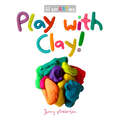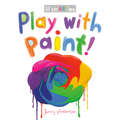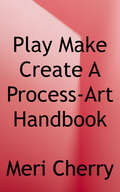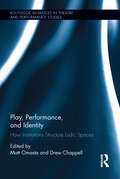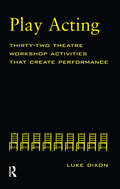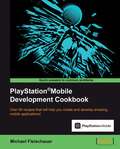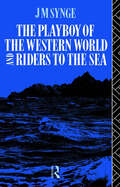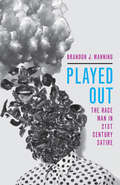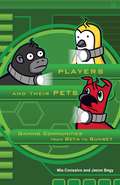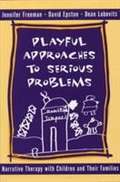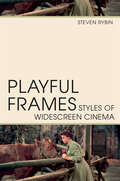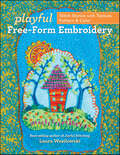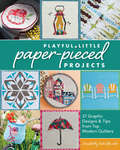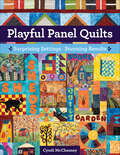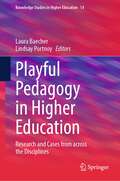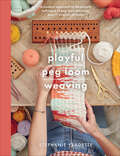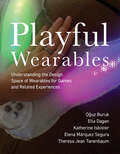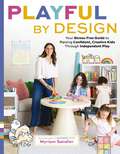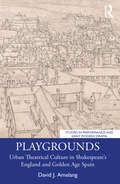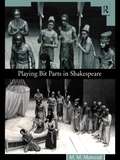- Table View
- List View
Play with Clay! (lil' smARTies)
by Jenny PinkertonFollow a colorful blob of modeling dough as it forms a ball, rolls into a snake, coils into a pot, and more in this adorable board book!In this charming story, children can learn the simple lesson that change is a constant--and they can learn it through art and play! The straightforward narrative paired with quirky visual humor makes this the perfect board book for budding creative kids.
Play with Paint! (lil' smARTies)
by Jenny PinkertonWhen it comes to painting, there are so many possibilities! Mix colors, swish your brush around, and see what sorts of marks you can make with just your hand and a bit of paint in this adorable board book!Creative play meets self-expression in this board book perfect for budding-artist babies!
Play, Make, Create, A Process-art Handbook: With 43 Art Invitations for kids creative activities and projects to inspire free thinking, mindfulness, and curiosity
by Meri CherryPacked with joyful and educational art experiences for kids, Play, Make, Create offers fun and engaging imaginative activities focused on the fun and reward of creating, not just producing a final project. Founded in a process-based philosophy, this unique book includes more than 40 activities set up as invitations, or thoughtfully designed prompts to explore, create, and play.
Play, Performance, and Identity: How Institutions Structure Ludic Spaces (Routledge Advances in Theatre & Performance Studies)
by Matt Omasta Drew ChappellPlay helps define who we are as human beings. However, many of the leisurely/ludic activities people participate in are created and governed by corporate entities with social, political, and business agendas. As such, it is critical that scholars understand and explicate the ideological underpinnings of played-through experiences and how they affect the player/performers who engage in them. This book explores how people play and why their play matters, with a particular interest in how ludic experiences are often constructed and controlled by the interests of institutions, including corporations, non-profit organizations, government agencies, religious organizations, and non-governmental organizations (NGOs). Each chapter explores diverse sites of play. From theme parks to comic conventions to massively-multiplayer online games, they probe what roles the designers of these experiences construct for players, and how such play might affect participants' identities and ideologies. Scholars of performance studies, leisure studies, media studies and sociology will find this book an essential reference when studying facets of play.
Play-Acting: A Guide to Theatre Workshops
by Luke DixonPlay-Acting is an inspired book of theatrical beginnings-jumping-off points for actors, teachers, and directors. Drawing upon his thirty years of designing and leading theater workshops, Luke Dixon goes to the heart of contemporary theater practice. Whether drawing upon Japanese butoh, Shakespearean verse, or African rhythms, these thirty-two workshops cover a wide range of activities-voice warm-ups, body work, the exploration of theatrical space, life games, dreamtime, sense and chakras, working with the spine, and much, much more. More than a collection of exercises, Play-Acting is constructed to take the user on a journey from learning about the anatomy of the individual actor's body to the performance of narrative by a group of actors. With tips on what you might expect to experience as an actor, teacher, or director, along with ideas on how to exploit the unexpected in performance, Play-Acting is a book to be read again and again.
PlayStation®Mobile Development Cookbook
by Michael FleischauerWritten as a series of engaging and practical recipes, this essential Cookbook has been meticulously designed and reviewed in order to provide you with the ultimate reference for PlayStation®Mobile development.If you've got some prior experience with C# and want to create awesome projects for the PlayStation®Vita and PlayStationTMCertified devices, then this book is for you.
Playa Fire: Spirit and Soul at Burning Man
by Stewart HarveyForeword by Burning Man founder Larry HarveyA stunning visual and narrative homage—featuring more than 100 black & white and color photographs, many never before seen—that captures the wonder and metaphysical power of Burning Man past present, and future, and the magic that draws us to it, by the ultimate Burning Man insider.Growing up in 1950s Oregon, brothers Stewart and Larry Harvey rebelled against their small-town culture and the conformist norms of Eisenhower’s America. Stewart turned to photography. Larry, drawn by the siren call of the burgeoning counter-cultural movement, fled to San Francisco, where he met a group of alternative artists like himself. During his frequent visits south, Stewart, camera always in hand, photographed the intimate creative worlds of Larry and his friends—images that would chronicle the birth of one of the most important cultural, artistic, and social movements of the twentieth century: Burning Man.Filled with the rare insights of Stewart’s decades-long friendships with his brother and the five other founders, as well as the many people who have shaped it, Playa Fire is a Burning Man story like no other. An artist and writer of striking emotional depth, Stewart marries stunning photos reflecting the beauty and grandeur of the desert landscape and the ephemeral, hallucinatory beauty of Black Rock City with a compelling narrative journey that captures the landmark festival’s spiritual essence.Drawn from his personal archives and taken over thirty years at Burning Man—many at "First Camp"—his panoramic photographs are accompanied by never-before-seen memorabilia, including Larry’s original sketch of the first Man as well as family photos of the young Harvey brothers and their band of merrymakers. An exquisite work of art that embodies the radical imagination at the core of this transformative event, Playa Fire celebrates both the spectacle and the meditative that is Burning Man. It is an enchanting portrait for die-hard "Burners," arts enthusiasts, and the intellectually curious fascinated by this iconoclastic, beloved cultural phenomenon.
Playboy of the Western World: A Comedy In Three Acts (Classic, 20th-century, Penguin Ser.)
by J.M SyngeFirst published in 1979. Routledge is an imprint of Taylor & Francis, an informa company.
Playboys and Killjoys: An Essay on the Theory and Practice of Comedy
by Harry LevinHarry Levin--one of America's major literary critics--offers a brilliant and original study of the whole world of comedy, concentrating on playwrights through the centuries, from Aristophanes and Plautus in classical times to Bernard Shaw and Bertolt Brecht and their recent successors. Viewing the comic repertory as a richly varied yet broadly unified whole, Levin provides a synthesis of theories and practice. Isolating two fundamental aspects of comedy--the ludicrous and irreverent "playboy," whom we laugh with, and the ridiculous and forbidding "killjoy," whom we laugh at--he traces the dialectical interplay of these components throughout history and across various cultures and media. While mainly focusing on the plays and the stage, with discussions of such major dramatists as Shakespeare, Ben Jonson, Moliere, and William Congreve, Levin also includes essays on such related topics as humor, satire, and games.
Played Out: The Race Man in Twenty-First-Century Satire
by Brandon J. ManningDating back to the blackface minstrel performances of Bert Williams and the trickster figure of Uncle Julius in Charles Chesnutt’s Conjure Tales, black humorists have negotiated American racial ideologies as they reclaimed the ability to represent themselves in the changing landscape of the early 20th century. Marginalized communities routinely use humor, specifically satire, to subvert the political, social, and cultural realities of race and racism in America. Through contemporary examples in popular culture and politics, including the work of Kendrick Lamar, Key and Peele and the presidency of Barack Obama and many others, in Played Out: The Race Man in 21st Century Satire author Brandon J. Manning examines how Black satirists create vulnerability to highlight the inner emotional lives of Black men. In focusing on vulnerability these satirists attend to America’s most basic assumptions about Black men. Contemporary Black satire is a highly visible and celebrated site of black masculine self-expression. Black satirists leverage this visibility to trouble discourses on race and gender in the Post-Civil Rights era. More specifically, contemporary Black satire uses laughter to decenter Black men from the socio-political tradition of the Race Man.
Players and Their Pets: Gaming Communities from Beta to Sunset
by Mia Consalvo Jason BegyIn the world of massively multiplayer online games (MMOGs), Faunasphere was but a blip on the screen in its short public life from 2009 to 2011. Its devoted players, many of them middle-aged women, entered a world that did not build on common fantasy or science-fiction tropes. There was no evil to defeat or realms to conquer, only friendly animals to care for and pollution to fight.In Players and Their Pets, Mia Consalvo and Jason Begy argue that its very difference makes it critically important—even more so than the large, commercially successful games such as World of Warcraft that have all too often shaped game studies discourse. Consalvo and Begy demonstrate how the beta period of an MMOG can establish social norms that guide how the game is played. They also show how a game&’s platform creates expectations for how the game will work and who is playing it—and what happens when those expectations clash with the reality. Even while telling the story of this particular game and its predominantly female players, however, Players and Their Pets cautions against oversimplifying players based on their gender. Faunasphere&’s playerbase enjoyed diverse aspects of the game, for varied reasons. No other game studies book tracks the entire life cycle of an online game to examine how the game evolved in terms of design as well as how its player community responded to changes and events. The brief life of Faunasphere makes this possible.
Playful Approaches to Serious Problems: Narrative Therapy with Children and their Families
by David Epston Jennifer Freeman Dean LobovitsThe "grown-up talk" of therapy is likely to turn off children - especially if it focuses on their problematic behavior. The highly effective techniques of narrative therapy include children by respecting their unique language, stories, and views of the world. This book describes a basic theory of collaborative narrative play, as well as verbal and nonverbal techniques that clear the way for stories of hope, possibility, and change. Compelling case examples, drawn from the authors' work, will appeal to parents and educators as well as therapists.
Playful Art (Fountas & Pinnell Classroom, Guided Reading)
by Laura SalasNIMAC-sourced textbook. Through an Artist's Eyes. Put your paints and markers away. There's only one thing you really have to have to be an artist. Find out what it is and see how artists use it.
Playful Frames: Styles of Widescreen Cinema (Techniques of the Moving Image)
by Steven RybinA widescreen frame in cinema beckons the eye to playfully, creatively roam. Such technology also gives inventive filmmakers room to disrupt and redirect audience expectations, surprising viewers through the use of a wider, more expansive screen. Playful Frames: Styles of Widescreen Cinema studies the poetics of the auteur-driven widescreen image, offering nimble, expansive analyses of the work of four distinctive filmmakers – Jean Negulesco, Blake Edwards, Robert Altman, and John Carpenter – who creatively inhabited the nooks and crannies of widescreen moviemaking during the final decades of the twentieth century. Exploring the relationship between aspect ratio and subject matter, Playful Frames shows how directors make puckish use of widescreen technology. All four of these distinctive filmmakers reimagined popular genres (such as melodrama, slapstick comedy, film noir, science fiction, and horror cinema) through their use of the wide frame, and each brings a range of intermedial interests (painting, performance, and music) to their use of the widescreen image. This study looks specifically at the technological underpinnings, aesthetic shapes, and interpretive implications of these four directors’ creative use of widescreen, offering a way to reconsider the way wide imagery still has the potential to amaze and move us today.
Playful Free-Form Embroidery: Stitch Stories with Texture, Pattern & Color
by Laura WasilowskiStitch a story! From the best-selling author of Joyful Stitching, Laura Wasilowski brings 6 new hand-embroidery projects with full-sized patterns and step-by-step pictorial directions. Bright and lively project designs include a whirling paint brush, a dancing bird, tea cups tipping, flowers blooming, a fuzzy sheep, and a happy acorn nut house. With the free-form embroidery approach, you can either follow the given directions, or allow your imagination to run wild and improv your own additions—there is no right or wrong! Plus, no special tools are needed—just felt or felted wool, perle cotton #12 and #8 threads, embroidery needles, and sewing equipment. Start your stitch story! Stitch 6 textured projects with easy-to-follow free-form embroidery instructions Each project features a unique stitch combination, including some wool applique Finished creations are visually stunning art work that can be treasured for a lifetime
Playful Little Paper-Pieced Projec: 37 Graphic Designs & Tips from Top Modern Quilters
by Tacha BruecherTop designers—including Joanna Wilczyncka, Daniel Rouse, and Ayumi Takahashi—share their valuable tips and fail-proof paper-piecing techniques.Playful Little Paper-Pieced Projects by Fat Quarterly Magazine cofounder Tacha Bruecher is a collection of paper-pieced projects featuring some of the best work from today’s most talented modern quilters. You can learn everything you need to know about foundation paper piecing, and then test your skills with 37 projects ranging in difficulty and complexity. Bursting with ideas and ingenuity, this book will inspire you to include paper piecing in all your sewing projects.Find designs from Ayumi Takahashi, Charise Randell, Lynne Goldsworthy, Cheryl Arkison, Amy Lobsiger, and many more.Includes 2 quilts, 17 small projects and a 12-block calendar quilt, plus a project from each of the monthly block patterns. There’s something for everyone, from quilts and aprons to a backgammon board and a camera bag.“Compilations are one of our favorite types of books because we get to see one thing presented in many different ways by some of the most talented peeps in our industry. And boy, do we love this one! . . . There are bags, a game board, home dec items and even a chair cushion!” —Generation Q Magazine
Playful Panel Quilts: Surprising Settings, Stunning Results
by Cyndi McChesneyTransform your treasured quilt panels into masterpieces with creative techniques! Explore the possibilities of creating small freeform quilts using a montage technique that will help you unleash your artistic flair. Using coordinating blocks like barns and books, you'll discover how to integrate panels into traditional quilt settings like Log Cabin and Irish Chain quilts and make them shine in row-by-row quilts. With step-by-step instructions and practical exercises, you'll learn the concepts and techniques to bring your panel quilt designs to life. From graphing personalized quilt blocks to drawing paper-pieced patterns, you'll have all the tools to create a truly unique masterpiece. Learn how to create a montage with panels and identify styles that work with repeated block settings like the Irish Chain or Storm at Sea Gain practical skills through exercises by piecing together and assembling art quilts from a pre-determined grid to create a unique panel quilt Row by row, make panels the key feature of your new quilt masterpiece by finding your theme and drafting coordinating blocks
Playful Pedagogy in Higher Education: Research and Cases from across the Disciplines (Knowledge Studies in Higher Education #14)
by Laura Baecher Lindsay PortnoyThis collection provides a wide array of concrete and inspiring "playful" approaches to teaching in a range of higher education contexts and discipline areas, grounded in the learning sciences and within a future-oriented revisioning of the university learning environment. Within the broad area of active learning strategies, this text offers a curated collection of creative innovations such as game-based learning, gamification of courses, escape rooms, semester-long quests, dramatic role-plays, artistic endeavors and more. Containing descriptive and impact research that evidences the power of playful pedagogy, this text will offer a range of novel, transferable and usable materials for readers to apply in their lecture halls and classrooms tomorrow.
Playful Peg Loom Weaving: A Modern Approach to the Ancient Technique of Peg Loom Weaving (Crafts Ser.)
by Stephanie FradetteThere has been a recent renaissance in our relationship and interaction with textiles in interior design. Playful Peg Loom Weaving breathes new life into an ancient traditional craft form with a choice of contemporary projects presented for a modern lifestyle. Fiber artist Stephanie Fradette introduces you to weaving with the peg loom and sticks in this vibrant and fun guide. Her thoughtfully curated selection of fresh, trending woven projects embrace contemporary color palettes, easily mastered techniques and high-quality materials to guarantee satisfying finished objects. Whether you have a few hours in the evening, a day off or a whole weekend to dedicate to creativity, the guide conveniently groups textile creations by duration. So whatever your inspiration and available time, the intuitive step-by-step collection of projects ensures everyday crafters and seasoned makers alike can embrace the ease and versatility of weaving on a peg. With plenty of techniques to discover, fiber alternatives and DIY resources, you can make it your own while experimenting with this meditative woven craft. Playful Peg Loom Weaving lets you play, have fun and relax, and in doing so, grow organically and creatively beyond the fleece. Whatever your inspiration or motivation, the new craft to master is Peg Loom Weaving.
Playful Precut Quilts: 15 Projects with Blocks to Mix & Match
by Amanda NeiderhauserModern precuts meet classic quilt blocks in this guide featuring 15 patterns by the popular quilt designer and author of the Jedi Craft Girl blog.Designer Amanda Niederhauser lets you into the creative process with quilt blocks that you can mix, match and customize with your own personal touch. Playful Precut Quilts features 15 different 12” blocks in an engaging variety of settings and sizes. You can make a sweet sampler quilt with all 15 blocks or repeat motifs for endless variations. Wherever you are on your quilt journey, these precut-friendly patterns make it a breeze to mix colors and prints. With designs that will appeal to every quilter, this book will quickly become your “go to” when you want to make a table runner for your friend’s birthday, a baby quilt for your newborn niece, or a throw for your parents’ anniversary.
Playful Wearables: Understanding the Design Space of Wearables for Games and Related Experiences
by Katherine Isbister Oguz Buruk Ella Dagan Elena Marquez Segura Theresa Jean TanenbaumAn expert introduction to the world of &“playful wearables&” and their design, with a wide range of engaging examples, case studies, and exercises.This pioneering introduction to the world of wearable technology takes readers beyond the practical realm (think Fitbits, Apple Watches, and smartglasses) to consider another important side of the technology—the playful. Playful Wearables offers an engaging account of what &“playful wearables&” are, why they matter, how they work, how they&’re made, and what their future might hold. The book&’s authors draw on decades of experience in design, development, and research to offer real-world examples, exercises, and implications, showing how this kind of wearable tech can introduce an invaluable element of play into our everyday lives.As wearable technology emerges in the ecology of costume and fashion, the authors consider its intimate connection to identity and culture. And they look at the ways in which playful wearables, when smoothly integrated into everyday social experiences, support social interaction. The book then moves on to the mechanics of playful wearables—from design strategies and frameworks to specific methods and game design patterns. All of these elements point to possibilities beyond the realm of games and dedicated play, as the value and uses of playful wearables in the larger world of self, society, and culture become ever more apparent.
Playful by Design: Your Stress-Free Guide to Raising Confident, Creative Kids through Independent Play
by Myriam SandlerHelp your kids grow into confident, creative, and independent little people by creating spaces in your home that foster independent play.Myriam Sandler, creator and founder of Mothercould, helps you give your kids the tools they need to unlock their imaginations and encourage kid-directed, kid-executed, and ultimately kid-enriching independent play using the materials and spaces you already have. Not only will this system help your children grow, it will also help foster a more connected, more productive, and happier home for your entire family.Through colorful photography and vibrant illustration Playful by Design is your blueprint for effortlessly designing, installing, and maintaining your own upgraded play spaces. Myriam Sandler has created a resource to help you—easily and affordably—create spaces for independent play, no matter how big or small your home is.Myriam shares activities that:Build problem-solving skillsEncourage social and academic developmentEngage children while building moments of play and connectionNurture independence and self-expressionHelp work through emotions, andOffer parents important parenting wins that benefit the entire family As your kids engage with self-directed, open-ended play, you'll realize what a game-changer this new dynamic is for the entire household. For the parents, there's no more feeling overwhelmed and stretched thin by unrealistic expectations about how to entertain your kids. And for your kids, you're giving them the most beautiful gift: the ability to be independent self-starters who are in touch with their own creativity. In short: everyone will feel happier, more energized, more fulfilled, and more connected.Myriam will help you:Plan the spaceDeclutterOrganize by type (and customize for various age groups!)Set up a toy rotation systemMaintain (easily and efficiently!) In addition to the how, Myriam explains the why. This beautifully designed book will equip you to understand the importance of independent play, as well as set it into motion. You'll discover that boredom can be a good thing, and you'll see how it can make their imaginations blossom. This type of play creates more time for your kids to grow as creative and independent little people; more time for you to do the things you need and want to do; more peace of mind that you are, in fact, giving your kids important tools they'll thank you for one day; and more opportunities to feel the joy of all of the above.
Playgrounds: Urban Theatrical Culture in Shakespeare’s England and Golden Age Spain (Studies in Performance and Early Modern Drama)
by David J. AmelangThis book compares the theatrical cultures of early modern England and Spain and explores the causes and consequences not just of the remarkable similarities but also of the visible differences between them. An exercise in multi-focal theatre history research, it deploys a wide range of perspectives and evidence with which to recreate the theatrical landscapes of these two countries and thus better understand how the specific conditions of performance actively contributed to the development of each country’s dramatic literature. This monograph develops an innovative comparative framework within which to explore the numerous similarities, as well as the notable differences, between early modern Europe’s two most prominent commercial theatre cultures. By highlighting the nuances and intricacies that make each theatrical culture unique while never losing sight of the fact that the two belong to the same broader cultural ecosystem, its dual focus should appeal to scholars and students of English and Spanish literature alike, as well as those interested in the broader history of European theatre. Learning from what one ‘playground’ – that is, the environment and circumstances out of which a dramatic tradition originates – reveals about the other will help solve not only the questions posed above but also others that still await examination. This investigation will be of great interest to students and scholars in theatre history, comparative drama, early modern drama, and performance culture.
Playhouses and Privilege: The Architecture of Elite Childhood
by Abigail A. Van SlyckExamining playhouses of the super-rich to understand how architecture contributed to the construction of elite identity and modern childhoodPlayhouses and Privilege explores children&’s playhouses built on British and American estates between the 1850s and the mid-1930s. Different from the prefabricated buildings that later populated suburban backyards, these playhouses were often fully functional cottages designed by well-known architects for British royalty, American industrialists, and Hollywood stars. As Abigail A. Van Slyck shows, these buildings were more than extravagant spaces to cultivate children&’s imaginations and fantasy lives. Reviewing a rich archive that includes extant buildings, site plans, family photographs, baby books, and intimate household correspondence, Van Slyck demonstrates that these structures were tools of social reproduction shaped by elite parents&’ attitudes toward child-rearing, education, and class privilege. Recognizing playhouses as stages for the purposeful performance of upper-class identity, she illuminates their importance in influencing children to internalize gendered codes of conduct as they enacted rituals of hospitality and learned how to supervise servants. From Queen Victoria and Prince Albert&’s Swiss Cottage, built on their Osborne estate in 1853, to the children&’s cottage constructed on the grounds of Cornelius Vanderbilt&’s Newport mansion in 1886, and from the miniature bungalow commissioned in 1926 for the Dodge Brothers Motor Company heiress to the corporate-sponsored glass-block playhouse given to Shirley Temple in 1936, Van Slyck surveys a variety of playhouses and their milieus to trace the evolution of elite childhood and the broader social practices of wealth. Playhouses and Privilege makes clear that, far from being frivolous, playhouses were carefully planned architectural manifestations of adult concerns, integral to the reproduction of class privilege.
Playing Bit Parts in Shakespeare
by Professor M Mahood M.M. MahoodPlaying Bit Parts in Shakespeare is a unique survey of the small supporting roles - such as foils, feeds, attendants and messengers - that feature in Shakespeare's plays. Exploring such issues as how bit players should conduct themselves within a scene, and how blank verse or prose may be spoken to bring out the complexities of character-definition, Playing Bit Parts in Shakespeare brings a wealth of insights to the dynamic of scenic construction in Shakespeare's dramaturgy. M.M. Mahood explores the different functions of minimal characters, from clearing the stage to epitomizing the overall effect of the comedy or tragedy, and looks at how they can extend the audience's knowledge of the social world of the play. She goes on to describe the entire corpus of minimal roles in a selection of six plays: * Richard III * The Tempest * King Lear * Antony & Cleopatra * Measure for Measure * Julius Caesar This new edition comes enhanced with a new Appendix, 'Who Says What', especially designed to aid directors in making decisions about the speaking parts of the minimal characters. It also comes complete with an index of characters (including line references) as well as a detailed general index. An invaluable aid for directors and actors in the rehearsal room, this perceptive and informative volume is equally of interest to students studying and writing about Shakespeare's plays.
